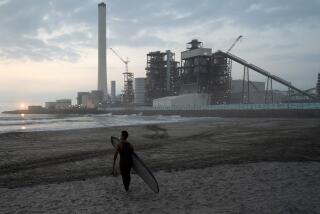Soviet Press Insists Dangers Have Been Contained : After 2 Years, Chernobyl Fears Persist
MOSCOW — Two years after an accident at the Chernobyl nuclear power station spread radiation across a wide area of the Soviet Union and the rest of the world, fears about the continuing side effects of the catastrophe continue to haunt this country.
For the last month, the Soviet press has been filled with articles leading up to today’s anniversary, which assert that the dangers from the Chernobyl accident have been successfully contained. Experts have been quoted as asserting that a similar accident could not happen again.
Although a report in the Communist Party newspaper Pravda over the weekend said that repair work at Chernobyl was often shoddy, leading to defective equipment being placed into operation, that newspaper nevertheless asserted that the plant is now safe.
By official count, 31 people died as a result of the Chernobyl accident April 26, 1986. About 135,000 persons were evacuated from a 20-mile wide area around the plant and have not been permitted to return.
Incidence of Cancer
A so-called “prohibited zone” has been established for six miles around the area of the nuclear power plant that will be used to study the effects of radiation on plant and animal life.
One Soviet expert quoted in the press said that theoretical studies showed that the incidence of cancer in the area should increase by about 100th of 1% but that the statistical deviation was too small to detect.
Workers and others who formerly lived in the town of Pripyat near the Chernobyl plant were originally moved to the Ukrainian capital of Kiev, 60 miles to the south.
A new town, Slavuvitch, is being built for Chernobyl workers about 30 miles away from the plant. Already, 500 residents have moved into Slavuvitch, according to the Tass news agency.
One Tass report noted that a special police unit has been established to patrol the protective zone around the plant. About 100 residents, mostly of them elderly, have slipped into the area to return to their homes, but Tass said they will not be forced to leave.
It noted that while there was virtually no crime reported in the area of contamination, several instances of theft have been reported, including rare books and icons that were contaminated by radiation.
Most of the attention has been focused on the continued operation of the Chernobyl complex after the accident two years ago.
The reactor where the accident took place, leading to an explosion and release of radiation, is one of four reactors at the Chernobyl complex. The damaged reactor has been sealed in a massive vault of concrete and surrounded by radioactive monitors.
The other three reactors have continued functioning at full capacity, according to the government newspaper Izvestia, producing about 20 million kilowatts of electricity in the past two years.
In its weekend report about shoddy work at Chernobyl, Pravda sharply criticized continued official emphasis on the power station’s output. The station’s officials gave first priority to “issues relating to the stations’ operation at the expense of the quality of repair work and maintenance of complicated equipment,” Pravda said.
It said that repairs were occasionally carried out “without due supervision and technological backup” and that equipment was put into service “with serious defects.”
The report said that because of these shortcomings, the head of the production unit responsible for Chernobyl has been fired and the power station’s manager has been reprimanded.
No Further Radiation
In the past few weeks, officials have proclaimed that no further radiation has been emitted from the plant in the form of radioactive aerosols and that other radiation at the damaged reactor was well below international safety standards.
Nikolai F. Lukonin, minister of nuclear power, issued a statement last week insisting that “foolproof safety devices have been installed at all of the country’s reactors, preventing a runaway nuclear reaction.
“One can say with confidence that even a recurrence of the errors which were made in Chernobyl would not lead to such a disaster,” Lukonin said.
Soviet newspapers have blamed “Chernobyl fears” on the decision taken in March to scrap construction of a new nuclear power station at Krasnodar. Opponents said the power plant was too near an earthquake fault to insure the safe operation of a nuclear facility.
Despite fears remaining after the Chernobyl accident, Soviet officials predict that the amount of power from nuclear sources will triple in the next five years.
“Humanity is now on the road of restructuring its energy system, which is still based on natural fuel,” said Yuri Semyonov, deputy chairman of the government commission that looked into the Chernobyl accident.
“There are estimates that such fuel will be enough until the middle of the next century, but nuclear, thermonuclear and solar energy are indispensable in the future.”
More to Read
Sign up for Essential California
The most important California stories and recommendations in your inbox every morning.
You may occasionally receive promotional content from the Los Angeles Times.










